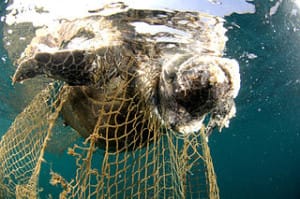Rodale News
by Leah Zerbe
There’s no doubt that eating the right seafood helps saturate your brain in healthy fats, possibly helping to ward off everything from Alzheimer’s to birth defects. It’s also true that fishing is a vital part of the way of life in coastal communities in the United States, bringing not just a paycheck, but also a sense of pride to fishermen and their families.
 |
But here’s the problem: By and large, we’re fishing all wrong, and in a way that’s creating enormous amounts of waste. Get this: Up to 22 percent of fish caught in U.S. fisheries is discarded before the ship even returns to port! A new Oceana report estimates that’s 2 billion pounds of fish wasted—long before the catch even reaches consumers.
This widespread waste is taking a toll on our oceans, disrupting ecosystems, and often tangling non-target species in nets and long lines, where they’re often dead by the time they reach the surface. While there have been innovations, such as nets better designed to help sea turtles escape, those aren’t the norm. However, Oceana is working to help fishermen implement more ocean-friendly methods to reduce their bycatch, and, as the group notes, fisherman could charge a premium if they advertise as using these more sustainable methods.
Oceana’s new Wasted Catch report exposes nine of the dirtiest fisheries in the U.S., highlighting how in combination they throw away nearly half of what they catch. “Anything can be bycatch,” says Dominique Cano-Stocco, campaign director at Oceana. “Whether it’s the thousands of sea turtles that are caught to bring you shrimp or the millions of pounds of cod and halibut that are thrown overboard after fishermen have reached their quota, bycatch is a waste of our ocean’s resources. Bycatch also represents a real economic loss when one fisherman trashes another fisherman’s catch.”
The fishing methods that are more detrimental to the sea include ocean trawl, in which nets are pulled behind boats; gillnet; and longline fisheries. “Hundreds of thousands of dolphins, whales, sharks, sea birds, sea turtles, and fish needlessly die each year as a result of indiscriminate fishing gear,” says Amanda Keledjian, the report’s author and a marine scientist at Oceana. “It’s no wonder that bycatch is such a significant problem, with trawls as wide as football fields, longlines extending up to 50 miles with thousands of baited hooks, and gillnets up to two miles long. The good news is that there are solutions—bycatch is avoidable.”
“The solution can be as simple as banning the use of drift gillnets, transitioning to proven cleaner fishing gears, requiring Turtle Excluder Devices in trawls, or avoiding bycatch hotspots,” says Geoff Shester, PhD, California program director at Oceana. “Proven solutions and innovative management strategies can significantly reduce the unnecessary deaths of sharks, sea turtles, dolphins, and other marine life, while maintaining vibrant fisheries.”
Click the infographic to view the hi-res version.
How You Can Enjoy Seafood and Help Protect the Oceans
Get familiar with Seafood Watch. Check Monterey Bay Aquarium’s Seafood Watch app or consumer guides.
Consider Super Green options.Seafood Watch IDs species that are low in contaminants, are rich in omega-3 fatty acids, and are more sustainable for our oceans, and includes them on the group’s Super Green list. They are:
•Atlantic Mackerel (purse seine from Canada and the U.S.)
•Freshwater Coho Salmon (farmed in tank systems, from the U.S.)
•Pacific Sardines (wild-caught)
•Salmon (wild-caught, from Alaska)
•Salmon, Canned (wild-caught, from Alaska).
Other healthy choices, notes Seafood Watch, include troll- or pole-caught albacore tuna from the U.S. or British Columbia and sablefish/black cod from Alaska and the Canadian Pacific.


